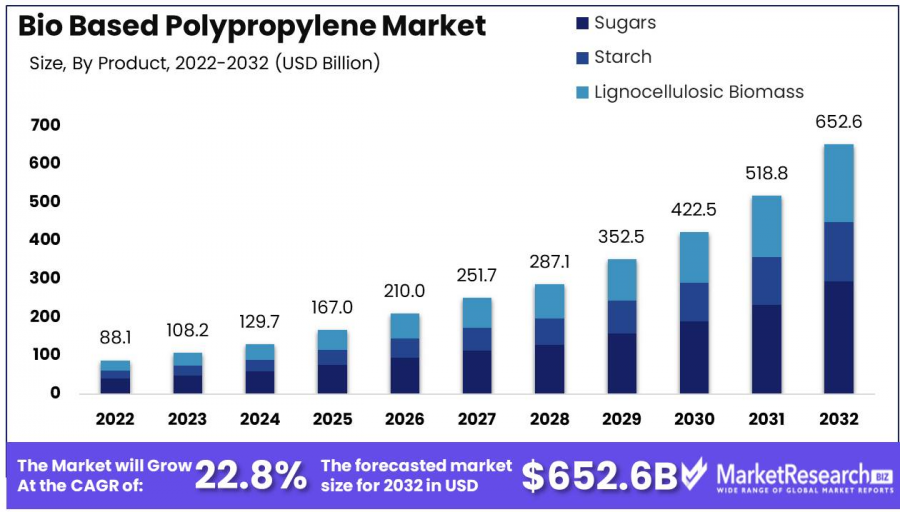
Bio-based Polypropylene Market Expected To Surge with 22.8% CAGR by 2032
Bio-Based Polypropylene Market size is expected to be worth around USD 652.6 Bn by 2032 from USD 88.1 Bn in 2022, growing at a CAGR of 22.8% from 2023 to 2032.
NEW YORK, NY, UNITED STATES, February 5, 2025 /EINPresswire.com/ -- The Bio-based Polypropylene Market is witnessing substantial growth, driven by the increasing demand for sustainable alternatives to traditional fossil fuel-based plastics. Bio-based polypropylene, derived from renewable biomass like agricultural refuse and plant-based materials, offers a promising solution to reduce carbon emissions and mitigate the environmental impact associated with conventional polypropylene. With a market size predicted to soar to USD 652.6 billion by 2032, up from USD 88.1 billion in 2022, the market is set to expand at a rapid CAGR of 22.8% from 2023 to 2032. The unique properties of bio-based polypropylene, such as biodegradability and comparable performance to traditional plastics, make it attractive for a wide range of applications across industries like packaging, automotive, and consumer goods. Innovations in biotechnology that improve production efficiency further bolster market growth. As consumer awareness grows and regulatory environments shift towards favoring sustainable materials, the bio-based polypropylene market is poised for continued expansion, offering industries a feasible pathway to meet their sustainability goals and reduce reliance on fossil fuels.
➤ 𝐒𝐚𝐦𝐩𝐥𝐞 𝐑𝐞𝐩𝐨𝐫𝐭 𝐑𝐞𝐪𝐮𝐞𝐬𝐭: 𝐔𝐧𝐥𝐨𝐜𝐤 𝐕𝐚𝐥𝐮𝐚𝐛𝐥𝐞 𝐈𝐧𝐬𝐢𝐠𝐡𝐭𝐬 𝐟𝐨𝐫 𝐘𝐨𝐮𝐫 𝐁𝐮𝐬𝐢𝐧𝐞𝐬𝐬: https://marketresearch.biz/report/bio-based-polypropylene-market/request-sample/
Experts Review
Government incentives are crucial in accelerating the adoption of bio-based polypropylene, as they encourage investments and innovations for greener production processes. Technological advances, such as enhanced polymer compatibility and genetic modifications for efficient production, improve material properties and expand application potential. However, investment opportunities come with risks, including price competitiveness challenges against conventional polypropylene. Consumers are increasingly aware of and demanding sustainable products, boosting market growth. The regulatory environment also supports this shift, with policies promoting renewable materials. Overall, bio-based polypropylene significantly impacts sustainability goals but must overcome cost-related restraints.
Report Segmentation
The bio-based polypropylene market is segmented by product and application. The primary product segments include sugars, starch, and lignocellulosic biomass, each offering unique properties and benefits for different industrial applications. The sugars segment currently dominates the market, driven by rising demand for sustainable materials in emerging economies. On the application front, injection molding leads, leveraging bio-based polypropylene's superior molding capabilities for creating diverse products like packaging and automotive components. Other pertinent applications encompass films and textiles, where bio-based polypropylene’s adaptability and eco-friendly credentials are highly valued. This segmentation showcases the varied potential and dynamic growth prospects within the bio-based polypropylene market landscape.
Key Market Segments
By Product
• Sugars
• Starch
• Lignocellulosic Biomass
By Application
• Injections
• Films
• Textile
• Other
➤ 𝐁𝐮𝐲 𝐍𝐨𝐰 𝐭𝐡𝐢𝐬 𝐏𝐫𝐞𝐦𝐢𝐮𝐦 𝐑𝐞𝐩𝐨𝐫𝐭 𝐭𝐨 𝐆𝐫𝐨𝐰 𝐲𝐨𝐮𝐫 𝐁𝐮𝐬𝐢𝐧𝐞𝐬𝐬: https://marketresearch.biz/purchase-report/?report_id=3874
Drivers, Restraints, Challenges, and Opportunities
1. Drivers: The surge in demand for sustainable and renewable plastics, coupled with the expansion of the automotive and consumer goods industries and technological advances in production processes, propels the market forward. Increasing focus on reducing greenhouse gas emissions also bolsters growth.
2. Restraints: Competitive pricing against traditional polypropylene poses a significant challenge. Achieving cost efficiency and economies of scale is currently constrained by lower production volumes.
3. Challenges: Variations in properties and performance depending on feedstock and manufacturing processes need addressing to meet industry standards consistently.
4. Opportunities: Collaboration with automotive and consumer goods industries, exploration of new applications, and development of non-food feedstocks offer promising avenues for growth and market penetration.
Key Player Analysis
Key players in the bio-based polypropylene market, such as Borealis AG, Braskem, and Mitsui Chemicals Inc., are at the forefront of innovation and sustainability. Borealis AG, with its advanced polyolefin solutions, is driving sustainability through significant R&D investments. Braskem leverages sugarcane-based production, positioning itself as a leading player in bio-plastics. Mitsui Chemicals focuses on plant-based feedstock, enhancing bio-based polypropylene's physical properties. These companies are pivotal in shaping the market landscape through technological advancements and sustainable practices, thereby contributing significantly to the industry's transformation towards eco-friendly materials.
• Borealis AG (Austria)
• Braskem (Brazil).
• Mitsui Chemicals Inc. (Japan).
• Novamont SpA (Italy)
• LyondellBasell Industries Holdings B.V (Netherland).
• NaturePlast (France)
• Neste (Finland)
• Global Bio-Energies (France),
• Trellis Earth Products Inc. (US)
• Biobent management sevices Inc. (US)
• Dow (US)
• Washington Penn (US)
• Solvay (Beigum)
• FKuR (Germany)
• China Petrochemical Corporation (China)
• Exxon Mobil Corporation (US)
• INEOS (UK)
• SABIC (Saudi Arabia)
Recent Developments
Recent developments in the bio-based polypropylene market highlight growing industry momentum. In 2023, NatureWorks announced its innovative bio-based polypropylene line, signaling a pivotal industry entry. Following suit, Braskem unveiled expansion plans for its bio-based PP portfolio in 2022, emphasizing its commitment to sustainability. Additionally, in 2021, Ford’s integration of bio-based PP into its electric vehicles marked a significant step in promoting renewable materials within automotive sectors. These strategic advancements underscore industry's readiness to embrace and accelerate the use of sustainable polymers, potentially setting new standards in environmental responsibility.
Conclusion
The Bio-based Polypropylene Market is poised for dynamic growth, driven by sustainability trends, government support, and technological innovations. Although challenges like cost competitiveness persist, the market offers considerable opportunities through strategic industry collaborations and innovation. As consumer demand for eco-friendly materials rises, the bio-based polypropylene market stands to play a vital role in the transition to a more sustainable and environmentally conscious future.
Lawrence John
Prudour
+91 91308 55334
Lawrence@prudour.com
Distribution channels: Chemical Industry
Legal Disclaimer:
EIN Presswire provides this news content "as is" without warranty of any kind. We do not accept any responsibility or liability for the accuracy, content, images, videos, licenses, completeness, legality, or reliability of the information contained in this article. If you have any complaints or copyright issues related to this article, kindly contact the author above.
Submit your press release


